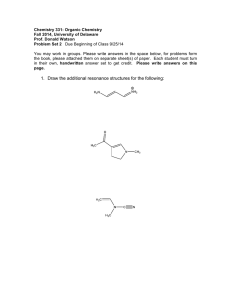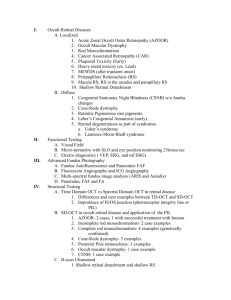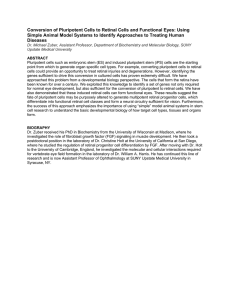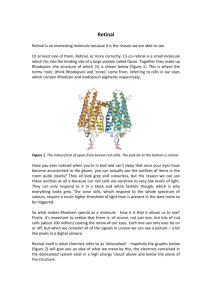avI33 VI385 Involvement integrins
advertisement
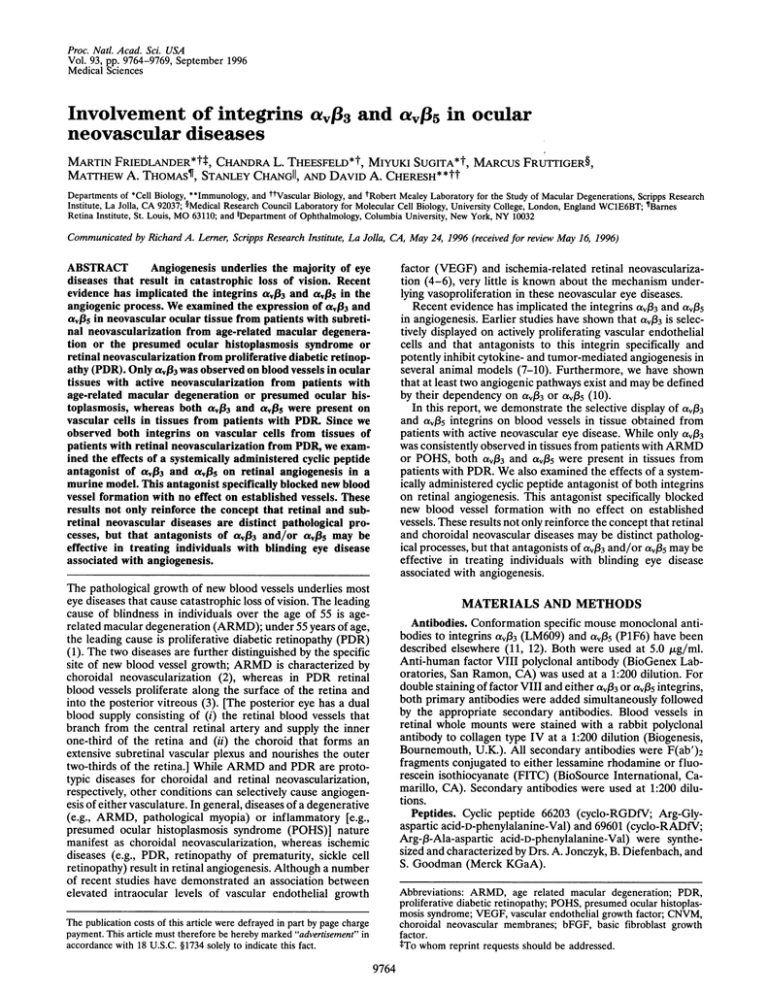
Proc. Natl. Acad. Sci. USA Vol. 93, pp. 9764-9769, September 1996 Medical Sciences Involvement of integrins avI33 and VI385 in ocular neovascular diseases MARTIN FRIEDLANDER* tt, CHANDRA L. THEESFELD*t, MIYUKI SUGITA*t, MARCUS FRUTFrIGER§, MATTHEW A. THOMAST, STANLEY CHANGII, AND DAVID A. CHERESH* * tt Departments of *Cell Biology, **Immunology, and ttVascular Biology, and tRobert Mealey Laboratory for the Study of Macular Degenerations, Scripps Research Institute, La Jolla, CA 92037; §Medical Research Council Laboratory for Molecular Cell Biology, University College, London, England WC1E6BT; lBames Retina Institute, St. Louis, MO 63110; and I1Department of Ophthalmology, Columbia University, New York, NY 10032 Communicated by Richard A. Lerner, Scripps Research Institute, La Jolla, CA, May 24, 1996 (received for review May 16, 1996) ABSTRACT Angiogenesis underlies the majority of eye diseases that result in catastrophic loss of vision. Recent evidence has implicated the integrins r4P3 and Cv435 in the angiogenic process. We examined the expression of C4133 and CX485 in neovascular ocular tissue from patients with subretinal neovascularization from age-related macular degeneration or the presumed ocular histoplasmosis syndrome or retinal neovascularization from proliferative diabetic retinopathy (PDR). Only rv13 was observed on blood vessels in ocular tissues with active neovascularization from patients with age-related macular degeneration or presumed ocular histoplasmosis, whereas both aP3 and aP5 were present on vascular cells in tissues from patients with PDR Since we observed both integrins on vascular cells from tissues of patients with retinal neovascularization from PDR, we examined the effects of a systemically administered cyclic peptide antagonist of aM83 and C4185 on retinal angiogenesis in a murine model. This antagonist specifically blocked new blood vessel formation with no effect on established vessels. These results not only reinforce the concept that retinal and subretinal neovascular diseases are distinct pathological processes, but that antagonists of a433 and/or aC45 may be effective in treating individuals with blinding eye disease associated with angiogenesis. factor (VEGF) and ischemia-related retinal neovascularization (4-6), very little is known about the mechanism underlying vasoproliferation in these neovascular eye diseases. Recent evidence has implicated the integrins av43 and av535 in angiogenesis. Earlier studies have shown that avI33 is selectively displayed on actively proliferating vascular endothelial cells and that antagonists to this integrin specifically and potently inhibit cytokine- and tumor-mediated angiogenesis in several animal models (7-10). Furthermore, we have shown that at least two angiogenic pathways exist and may be defined by their dependency on avP33 or avf35 (10). In this report, we demonstrate the selective display of av33 and avPis integrins on blood vessels in tissue obtained from patients with active neovascular eye disease. While only av33 was consistently observed in tissues from patients with ARMD or POHS, both avf33 and avB5 were present in tissues from patients with PDR. We also examined the effects of a systemically administered cyclic peptide antagonist of both integrins on retinal angiogenesis. This antagonist specifically blocked new blood vessel formation with no effect on established vessels. These results not only reinforce the concept that retinal and choroidal neovascular diseases may be distinct pathological processes, but that antagonists of avf33 and/or av135 may be effective in treating individuals with blinding eye disease associated with angiogenesis. The pathological growth of new blood vessels underlies most eye diseases that cause catastrophic loss of vision. The leading cause of blindness in individuals over the age of 55 is agerelated macular degeneration (ARMD); under 55 years of age, the leading cause is proliferative diabetic retinopathy (PDR) (1). The two diseases are further distinguished by the specific site of new blood vessel growth; ARMD is characterized by choroidal neovascularization (2), whereas in PDR retinal blood vessels proliferate along the surface of the retina and into the posterior vitreous (3). [The posterior eye has a dual blood supply consisting of (i) the retinal blood vessels that branch from the central retinal artery and supply the inner one-third of the retina and (ii) the choroid that forms an extensive subretinal vascular plexus and nourishes the outer two-thirds of the retina.] While ARMD and PDR are prototypic diseases for choroidal and retinal neovascularization, respectively, other conditions can selectively cause angiogenesis of either vasculature. In general, diseases of a degenerative (e.g., ARMD, pathological myopia) or inflammatory [e.g., presumed ocular histoplasmosis syndrome (POHS)] nature manifest as choroidal neovascularization, whereas ischemic diseases (e.g., PDR, retinopathy of prematurity, sickle cell retinopathy) result in retinal angiogenesis. Although a number of recent studies have demonstrated an association between elevated intraocular levels of vascular endothelial growth MATERIALS AND METHODS Antibodies. Conformation specific mouse monoclonal antibodies to integrins aVI33 (LM609) and ctV53s (P1F6) have been described elsewhere (11, 12). Both were used at 5.0 ,ug/ml. Anti-human factor VIII polyclonal antibody (BioGenex Laboratories, San Ramon, CA) was used at a 1:200 dilution. For double staining of factor VIII and either av133 or avI3s integrins, both primary antibodies were added simultaneously followed by the appropriate secondary antibodies. Blood vessels in retinal whole mounts were stained with a rabbit polyclonal antibody to collagen type IV at a 1:200 dilution (Biogenesis, Bournemouth, U.K.). All secondary antibodies were F(ab')2 fragments conjugated to either lessamine rhodamine or fluorescein isothiocyanate (FITC) (BioSource International, Camarillo, CA). Secondary antibodies were used at 1:200 dilutions. Peptides. Cyclic peptide 66203 (cyclo-RGDfV; Arg-Glyaspartic acid-D-phenylalanine-Val) and 69601 (cyclo-RADfV; Arg-,B-Ala-aspartic acid-D-phenylalanine-Val) were synthesized and characterized by Drs. A. Jonczyk, B. Diefenbach, and S. Goodman (Merck KGaA). Abbreviations: ARMD, age related macular degeneration; PDR, proliferative diabetic retinopathy; POHS, presumed ocular histoplasmosis syndrome; VEGF, vascular endothelial growth factor; CNVM, choroidal neovascular membranes; bFGF, basic fibroblast growth The publication costs of this article were defrayed in part by page charge payment. This article must therefore be hereby marked "advertisement" in accordance with 18 U.S.C. §1734 solely to indicate this fact. factor. 4To whom reprint requests should be addressed. 9764 Medical Sciences: Friedlander et al. Immunofluorescence of Human Ocular Tissue. Nondiseased human tissue was received within 24 hr of enucleation from the San Diego Eye Bank. Specimens were kept at 4°C in a humid chamber until received. Eyes were bisected and frozen on dry ice in Tissue Tek O.C.T compound (Miles). Retinal or choroidal membranes were removed at vitrectomy and immediately placed in O.C.T and frozen on dry ice. Specimens were collected from eyes with retinal neovascular (PDR or von Hippel-Lindau), choroidal neovascular (ARMD, POHS, or idiopathic), or fibroproliferative (proliferative vitreoretinopathy or epiretinal membranes) diseases. Serial sagittal sections of normal human donor eyes or human neovascular membranes were examined for the presence of avf33 and avI35 integrins. Blood vessels were identified by positive staining with anti-factor VIII antibodies (13). Each section was double stained with either mouse monoclonal antibody to av33 or avf35 and rabbit polyclonal antibody to factor VIII, permitting co-localization of integrins and blood vessels. Frozen sections, cut 4-6 ,um thick, were fixed in 100% acetone for 30 sec, dried, briefly rehydrated in phosphatebuffered saline (PBS) and incubated in a moist chamber as follows: 5.0% BSA (Sigma) in PBS for 1 hr, primary antibodies for 1 hr at room temperature, five washes in PBS for 5 min each, secondary antibodies conjugated to fluorochromes for 1 hr at room temperature, five more washes as before. Samples were mounted with Fluoromount G (Southern Biotechnology Associates) and observed and photographed with an Olympus fluorescent microscope. All antibodies were diluted in 5.0% bovine serum albumin (BSA). Murine Retinal Whole Mounts. Newborn mice were injected subcutaneously twice daily for 4 days starting from day 0 either with a cyclic RGDfV peptide integrin antagonist that binds to aCv33 and aVI5 receptors or with a control cyclic RADfV peptide that does not bind to the receptors. On postnatal day 4, globes were removed and fixed in 4.0% paraformaldehyde Proc. Natl. Acad. Sci. USA 93 (1996) 9765 (PFA) at room temperature. Whole retinas were dissected from the globes, placed in cold methanol in a 24-well culture plate for no less than 10 min, and processed as follows. They were blocked for 1 hr in 50% fetal calf serum (FCS) and 1.0% Triton X-100 at room temperature, incubated overnight with primary antibodies, washed 20 min with PBS, incubated 3-4 hr with secondary antibodies, washed 20 min with PBS, and mounted in Slow Fade (Molecular Probes). Samples were observed and photographed with an Olympus fluorescent microscope or a Bio-Rad MRC1024 Laser Scanning Confocal Microscope. Antibodies were diluted in 10% FCS in PBS. Quantitation of Mouse Retinal Angiogenesis. We have quantitated the amount of angiogenesis in the mouse retinal model using two approaches. The first involves measuring the distance from the optic nerve head to the most distal point of a single vessel selected in each of six sectors: 2, 4, 6, 8, 10, and 12 o'clock. The mean distance is calculated and averaged with similar data obtained from an entire litter. We also used another approach to quantitate angiogenesis that takes into account the geometric irregularities of retinal vessel growth. To more accurately estimate the total volume of retinal blood vessels, the entire specimen was scanned in 2.0 ,um thick optical sections and stored digitally. The "seed" function in LASERSHARP software (Bio-Rad) was then used to threshold and count cubic pixels in each section. A macro was written to sum the volume of all sections and determine the value for all vascular structures. RESULTS Integrins C433 and a,3Bs Are Not Expressed in Normal and Proliferative Vitreoretinopathic Human Tissue. To evaluate the expression of integrins acr33 and ca435 in ocular diseases associated with neovascularization, we used conformationspecific monoclonal antibodies to each integrin and a poly- FIG. 1. Normal human ocular tissue stained with anti-factor VIII antibodies (A and C) and monoclonal antibody to integrins acr33 (B) or cavI35 (D). Staining with antiserum to factor VIII results in immunofluorescent labeling of choroidal (large arrow) or retinal (small arrow) vessels. Bright fluorescence of the retinal pigment epithelium is due to autofluorescence of lipofuchsin. Staining with either integrin antibody does not produce any positive vascular fluorescence. (Bar = 100 ,um.) 9766 Medical Sciences: Friedlander et al. Proc. Natl. Acad. Sci. USA 93 clonal antibody to factor VIII. Staining with anti-factor VIII produced positive immunofluorescence in all predicted vascular structures of normal human eyes including the conjunctiva, episclera, sclera, iris, ciliary body, retina, choroid, and optic nerve. Representative sagittal sections of the posterior segment are shown in Fig. 1. Intense yellow and red autofluorescences at 494 and 570 nm excitation wavelengths, respectively, were uniformly observed in the retinal pigment epithelium, consistent with the known characteristics of lipofuchsin granules present in these cells (14). Consecutive sections were costained with anti-factor VIII antibody (Fig. 1A) and LM609 (for atv3 integrin, Fig. 1B) or anti-factor-VIII antibody (Fig. 1C) and P1F6 (for av35 integrin, Fig. 1D). Ocular tissue was negative for integrins with the exception of occasional cellular elements in the corneal stroma or the elastic membrane of small muscular arteries found posteriorly in the adventitia (data not shown). Nonvascular, fibroproliferative ocular tissues obtained at surgery on patients with proliferative vitreoretinopathy (four specimens) or epiretinal membranes (two specimens) were negative for both factor VIII and each integrin (data not shown). Interestingly, one patient with proliferative vitreoretinopathy had a factor VIII-positive vascular structure present that was negative for avP3 or avP5 (data not shown). Integrin av,j3 Is Selectively Expressed in Choroidal Neovascular Membranes (CNVM). Nineteen specimens were removed at surgery from patients with subretinal (choroidal) neovascularization due to POHS (eight specimens) or ARMD (1996) (five membranes). Six membranes were categorized as idiopathic. Clinical examination and fluorescein angiograms were reviewed to approximate how long the membrane had been clinically present and whether it was fibrotic or actively leaking. Twelve specimens had structures clearly identifiable as blood vessels on the basis of histological appearance and factor VIII localization. In general (8 of 12 specimens), the presence of factor VIII-positive blood vessels correlated with the presence of clinically active (leaking fluorescein on angiography) CNVM (Fig. 2A and C). Of these, 75% (six of eight specimens) demonstrated colocalization between factor VIII and atv3 immunofluorescence (Fig. 2B). Costaining with anti-factor VIII and anti-av35 antibodies revealed only an occasional weak immunofluorescent signal (Fig. 2D). Integrins a433 and a,(8s Are Expressed in Retinal Neovascular Membranes. Seven specimens were examined from patients with active vasoproliferative retinopathy as documented clinically (five patients had PDR, one had von HippelLindau retinopathy, and one had idiopathic retinopathy). Each of these specimens showed blood vessels positive for factor VIII (Fig. 3 A and C). Double staining with factor VIII antibody and each of the integrin antibodies revealed colocalization between each integrin and factor VIII (Fig. 3 B and D); the vascular endothelial cells were positive and this fluorescence was uniform and intense. Tissue stained for avf35, in addition to blood vessels, had nonvascular areas positive for staining (Fig. 3D). In contrast, aVI3 strictly colocalized with blood vessels only (Fig. 3B). These findings reveal that both Choroidal neovascular membranes _U FIG. 2. Human choroidal neovascular membranes were obtained at vitrectomy and stained with anti-factor VIII polyclonal antibody (A and C) and monoclonal antibodies to the integrins avP3 (LM609) (B) or aC05 (P1F6) (D). Note that the specimen has numerous vascular structures that stain positive with anti-factor VIII antibody. These same structures demonstrate immunofluorescent colocalization after staining with LM609. In contrast, staining with P1F6 results in few positive vessels with minimal fluorescence. Focal, intense fluorescence (arrows) is the result of autofluorescence associated with lipofuchsin granules of the retinal pigment epithelium. (Bars = 100 ,um.) Medical Sciences: Friedlander et al. Proc. Natl. Acad. Sci. USA 93 (1996) 9767 cular membranes I FIG. 3. Human retinal neovascular membranes were obtained at vitrectomy and stained with anti-factor VIII polyclonal antibody (A and C) and monoclonal antibodies to the integrins av,I3 (LM609) (B) or aCM35 (P1F6) (D). A number of vascular structures were observed in these specimens after staining with anti-factor VIII antibody (A and C). The same structures demonstrate immunofluorescence colocalization after staining with either LM609 (B) or P1F6 (D). In addition, note that several nonvascular areas have positive immunofluorescence after staining with P1F6. (Bar = 100 ,um.) aVI33 and av135 colocalize with vascular endothelium in neovascular retinal tissue. Systemically Administered Peptide Antagonists of Integrins £4143 and a4,85 Inhibit Retinal Vasculogenesis in a Mouse Model. Since we had observed the presence of both avP3 and avl35 integrins on human retinal neovascular structures, we decided to examine whether a peptide antagonist of these integrins could inhibit postnatal retinal vessel formation in the mouse. Newborn mice develop retinal vessels during the first 2 weeks postnatally, during which time the superficial retinal vasculature forms a highly branched network of vessels that originate at the optic nerve head and radiate peripherally to cover the retinal surface in a manner similar to that observed in rats, cats, and humans (15). Collagen IV present on the surface of these vessels was used to identify the vasculature by immunofluorescence (16). Neonatal mice were injected subcutaneously twice daily for 4 days with 20 jig of a peptide antagonist of atvP3 and avI35 integrins. As shown in Fig. 4, this treatment dramatically reduced retinal vessel growth relative to animals injected with a control peptide. Importantly, mice followed for as long as 2 months after treatment with cyclic RGDfV peptide antagonists appear normal clinically and do not manifest any histopathology systemically or in the eye (data not shown). As detailed in Materials and Methods, we used two approaches to quantitate the extent of retinal vascularization. In the first method, we directly measured vessel growth in two dimensions from photomicrographs. When measured in this fashion, we found that systemically administered peptide antagonist inhibited retinal vasculogenesis, relative to control peptide, by 42% (n = 9, P < 0.01, paired t test). No statistically significant difference was noted between untreated newborn mice (Fig. 4, P0) and RGDfV peptide-treated 4-day-old mice (Fig. 4, P4 + RGD) or between 4-day-old untreated mice (Fig. 4, P4) and RADfV peptide-treated 4-day-old mice (Fig. 4, P4 + RAD). Thus, inhibition of retinal vasculogenesis in RGDfV-treated animals when compared with untreated newborns is effectively 100%. The second method took into account the three dimensional nature of vessel growth. With this approach, we observed a 78% reduction in the retinal vascular volume in the cyclic-RGDfVtreated animals (Fig. 5A) compared with the control cyclicRADfV-treated animals (Fig. 5B). The mean volume ofvessels on postnatal day 4 was 3.6 x 106 1Im3 and 15.7 x 106 ,um3 for antagonist- and control-treated mice, respectively. DISCUSSION Neovascular disease in different tissues may induce distinct pathways of angiogenesis. Earlier experiments using chicken chorioallantoic membrane and rabbit corneal models demonstrated that at least two such pathways exist: (i) one mediated by aq33 and induced by basic fibroblast growth factor (bFGF) and tissue necrosis factor a and (ii) the other mediated by avI3s and induced by VEGF, transforming growth factor a, and the phorbol ester phorbol 12-myristate 13-acetate (PMA) (10). The data presented in this study suggest that such distinct pathways may exist in ocular neovascular diseases and may play a role in the pathophysiology of both retinal and choroidal neovascular diseases in humans. We used conformationspecific monoclonal antibodies to localize aCv13 and avI5 integrin expression in normal and neovascular human eye tissue. Antibodies to a vascular endothelial cell marker, factor VIII, has been used to simultaneously identify vascular structures in the same sections. We did not observe either integrin associated with any vascular endothelium in normal human eyes. Occasional positive immunofluorescence was associated with fibroblast-like elements of the corneal and scleral stroma and the elastic membranes of small arteries. These observa- 9768 Medical Sciences: Friedlander et al. PO P4+RGD Proc. Natl. Acad. Sci. USA 93 P4 + RAD (1996) P4 II_ II_ II_ I FIG. 4. Retinal whole mounts were prepared as described in the text and stained for collagen IV to delineate the retinal blood vessels. Newborn retinas (P0) were observed to already have a small network of retinal vessels formed around the optic nerve head, radiating peripherally. The vessels varied in length and were mostly individual vessels, rather than a connected network. Four-day-old retinas (P4) possessed a well-developed network of vessels radiating peripherally from the optic nerve head, extending approximately 25-30% of the distance to the retinal periphery. Shortly after birth, treated mice were injected subcutaneously twice daily with 20 ,ug of cyclic RGDfV peptide integrin antagonists (P4 + RGD) or control cyclic RADfV (P4 + RAD). Mice treated with peptide antagonists of av33 and avc35 integrins appeared identical to untreated newborn mouse retinas; minimal retinal vascular development had occurred and the vessels present were only minimally networked with other vessels. In contrast, mice treated for the first 4 days after birth with control RADfV peptides appeared nearly identical to comparably aged, but untreated, 4-day-old mice. Extensive networks of retinal vessels were observed to cover a distance from the optic nerve head to the retinal periphery comparable to that observed in untreated animals. mouse tions are consistent with reports by others that acr45 is found connective tissue cell (e.g., fibroblasts) surfaces (17-19). Mature ocular vasculature does not express either a43 or av35, consistent with earlier work showing that integrin av33 is a marker of actively proliferating vascular endothelial cells (8). In light of these earlier observations, it was not surprising to find that both integrins showed increased expression in vascular tissue from patients with proliferative retinal vascular disease such as PDR and von Hippel-Lindau. Their absence in proliferative vitreoretinopathy serves to strengthen the conon A FIG. 5. Laser scanning confocal microscopy of retinal vasculature in mice after 4 days of subcutaneously administered RGDfV antagonist peptide (A) or RADfV control peptide (B). As discussed, the volume occupied by the vascular network in A was calculated to be 3.6 x 106 ,um3; the volume in B was calculated to be 15.7 x 106 ,um3. Treatment with RGDfV peptide antagonists resulted in a 78% reduction of vascularization relative to RADfV-treated animals. cept that only proliferating vascular endothelial cells express aVI33 and avc35. On actively proliferating choroidal neovascular membranes, avc33 colocalizes with factor VIII on vascular endothelial cells. The integrin Cr0Is does not appear to be expressed. This observation stands in contrast to retinal neovascular tissue in which both cr433 and av,B3 are highly expressed. These observations may be interpreted in the context of earlier studies that described two cytokine-dependent angiogenic pathways defined by avc33 or avi35 integrins (10). In these earlier studies, we observed that cytokine-stimulated angiogenesis proceeded via avc33 when bFGF or tissue necrosis factor a was used. When VEGF, transforming growth factor a, or PMA was the stimulus, an av,85-mediated pathway was used and was protein kinase C-dependent. Since we observed only av433 on CNVM, one interpretation would be that VEGF is not a significant angiogenic stimulus in subretinal neovascular diseases. Both cr43 and acP5 are expressed at higher levels in proliferative retinal vascular disease, which may suggest that both bFGF and VEGF play a role in the neovascular response in retinal neovascular diseases. Many recent studies have focused on the possible role of cytokines in neovascular eye disease and several studies suggest that VEGF is the major source of angiogenic stimulus in human PDR and other ischemic retinopathies (4, 5, 6, 20). In animal models of ischemic retinopathy, VEGF antagonists reduce retinal neovascularization by less than 50% (6). There are no data to directly demonstrate a similar role in choroidal neovascular disease. Recent studies of human CNVM have demonstrated a widespread distribution of bFGF in these tissues (21, 22). Our data suggest that Medical Sciences: Friedlander et aL both VEGF and bFGF are likely to play a role in PDR, but that bFGF, or some other non-VEGF cytokine, is a significant stimulus in nonischemic choroidal neovascularization. Furthermore, these data reinforce the concept that retinal and choroidal neovascular diseases proceed by distinct pathological processes. Systemically administered peptide antagonists of integrins av13 and av35 dramatically arrested retinal neovascularization in neonatal mice. In rodents, this process begins shortly before birth when astrocytes migrate out of the optic nerve head (23), possibly in response to platelet-derived growth factor a produced by retinal ganglion cells (24). As the astrocyte front moves peripherally, underlying vascular precursor cells (angioblasts) are induced to form differentiated vascular structures, possibly in response to VEGF secreted by the astrocytes (25). This event may be similar to primordial endothelial cell differentiation that occurs earlier in embryonic development and has been shown to be dependent on av,43 integrin for maturation of these blood vessels (26). Thus, it is not surprising to find that retinal vasculogenesis is also sensitive to an antagonist of av,13 and av35. Recently, this same peptide antagonist has been shown to inhibit hypoxia-induced retinal neovascularization (27). Drugs with specificity for both avf33 and av,5 integrins, such as the peptide antagonists used in this study or peptide mimetics, may represent a class of therapeutics that are useful in inhibiting ocular neovascular diseases that use the two angiogenic pathways described above. The observation that they may be administered subcutaneously without systemic effects provides an advantage in that local intraocular administration may not be necessary. The use of integrin antagonists as anti-angiogenic agents represents a potentially powerful therapeutic approach; the mechanism of action is wellcharacterized, they appear to be highly specific for actively proliferating vascular endothelial cells with no significant effect on mature blood vessels and they interfere with angiogenesis at a final common pathway, regardless of the specific angiogenic stimulus. We are very grateful to Dr. Bill Richardson for helpful discussions and suggestions concerning vasculogenesis in the mouse retinal model; to Drs. Albrecht Luckenbach, Alfred Jonczyk, Simon Goodman, and Arne Sutter (all from Merck KGaA) for providing us with the cyclic peptides and valuable information concerning their properties; to Drs. Peter Brooks, Sheila Fallon, and Edith Aguilar for helpful discussions; and to Dr. Gustavo Coll for assistance in collecting tissue specimens. We thank Dr. Glenn Nemerow for the use of his fluorescent microscope and James Hayden, Samuel Tesfai, and Phil Cyr (all from Bio-Rad) for their assistance in use of the Bio-Rad MRC1024 Laser Scanning Confocal Microscope. This work was supported by the Robert Mealey Laboratory for the Study of Macular Degenerations and grants to M. Friedlander from the National Eye Institute (EY11254), the Lions Sightfirst/American Diabetes Association Diabetic Retinopathy Research Program, the Scripps Clinic Department of Academic Affairs Research Program, and the RalWhbNbg Fund. D.A.C. is the recipient of an American Cancer Society Faculty Proc. Natl. Acad. Sci. USA 93 (1996) 9769 Research Award and a National Heart and Lung and Blood Institute Grant (HL54444). 1. Klein, R., Klein, B. E. K., Moss, S. E. & Cruickshanks, K. J. (1994) Arch. Ophthalmol. 112, 1217-1228. 2. Ryan, S. (1989) in Retina, ed. S. J. Ryan, (Mosby, St. Louis), pp. 107-125. 3. Miller, J. W., D'Amico, D. J. (1994) in Principles and Practice of Ophthalmology, eds. Albert, D. & Jacobiec, F. (Saunders, Philadelphia), pp. 760-781. 4. Adamis, A. P., Miller, J. W., Bernal, M. T., d'Amico, D. J., Folkman, J., Yeo, T-S. & Yeo, M. T. (1994) Am. J. Ophthalmol. 118, 445-450. 5. Aiello, L. P., Avery, R. L., Arrig, P. G., Keyt, B. A., Jampel, H. D., Shah, S. T., Pasquale, L. R., Thieme, H., Iwamoto, M. A., Park, J. E., Nguyen, H. V., Aiello, L. M., Ferrara, N. & King, G. L. (1994) N. Engl. J. Med. 331, 1480-1487. 6. Aiello, L. P., Pierce, E. A., Foley, E. D., Takagi, H., Chen, H., Riddle, L., Ferrara, N., King, G. L. & Smith, L. E. H. (1995) Proc. Natl. Acad. Sci. USA 92, 10475-10461. 7. Brooks, P. C., Montgomery, A. M., Rosenfield, M., Reisfeld, R. A., Hu, T., Klier, G. & Cheresh, D. A. (1994) Cell 79, 1157-1164. 8. Brooks, P. C., Clark, R. A. F. & Cheresh, D. A. (1994) Science 264, 569-571. 9. Brooks, P. C., Stromblad, S., Klemke, R., Visscher, D., Sarkar, F. H. & Cheresh, D. A. (1995) J Clin. Invest. 96, 1815-1822. 10. Friedlander, M. F., Brooks, P. C., Shaffer, R. W., Kincaid, K. M., Varner, J. A. & Cheresh, D. A. (1995) Science 270, 1500-1502. 11. Cheresh, D. A. (1987) Proc. Natl. Acad. Sci. USA 84, 6471-6475. 12. Wayner, E. A., Orlando, R. A. & Cheresh, D. A. (1991) J. Cell Biol. 113, 919-929. 13. Sehested, M. & Hou-Jensen, K. (1981) Pathol. Anat. 391, 217225. 14. Feeney, L. (1978) Invest. Ophthalmol. Vis. Sci. 17, 583-600. 15. Jiang, B., Bezhadian, M. A. & Caldwell, R. B. (1995) Glia 15, 1-10. 16. Bailey, A. J., Sloane, J. P., Trickey, B. S. & Ormerod, M. G. (1982) J. Pathol. 137, 13-23. 17. Elner, S. G. & Elner, V. M. (1996) Invest. Ophthalmol. Vis. Sci. 37, 696-701. 18. Brem, R. B., Robbins, S. G., Wilson, D. J., O'Rourke, L. M., Mixon, R. N., Robertson, J. E., Planck, S. R. & Rosenbaum, J. T. (1994) Invest. Ophthalmol. Vis. Sci. 35, 3466-3474. 19. Pasquilini, R., Bodorova, J., Ye, S. & Hemler, M. E. (1993)J. Cell Sci. 105, 101-111. 20. Pe'er, J., Shweiki, D., Ahuva, I., Hemo, I., Gnessin, H. & Keshet, E. (1995) Lab. Invest. 72, 638-45. 21. Amin, R., Puklin, J. E. & Frank, R. N. (1994) Invest. Ophthalmol. Vis. Sci. 35, 3178-3188. 22. Reddy, V. M., Zamora, R. L. & Kaplan, H. J. (1995) Am. J. Ophthalmol. 120, 291-301. 23. Watanabe, T. & Raff, M. (1988) Nature (London) 332, 834-836. 24. Mudhar, H. S., Pollock, R. A., Wang, C., Stiles, C. D. & Richardson, W. D. (1993) Development (Cambridge, UK) 118, 539552. 25. Stone, J. & Dreher, Z. (1987) J. Comp. Neurol. 255, 35-49. 26. Drake, C. J., Cheresh, D. A.-& Little, C. D. (1995)J. Cell Sci. 108, 2655-2661. 27. Hammes, H.-P., Brownlee, M., Jonczyk, A., Sutter, A. & Preissner, K. T. (1996) Nat. Med. 2, 529-533.

